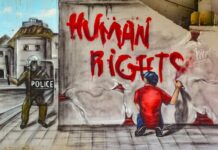What happened at Pretoria High School for Girls is but an example of the lived experiences of discrimination against African hair in schools. But it’s not just about school rules. It’s about how you have to change yourself to comply with the school rules. It’s about being forced to assimilate to norms of whiteness. The Daily Vox asked people about the kinds of treatment they received at their schools for their hair.
*Mbali Zulu, 18, Pretoria High School for Girls
I have dreadlocks. [The treatment has been] very volatile since the beginning of time at Girls High. My hair has been referred to as a bird’s nest on countless occasions. It’s been referred to as braids because they’re ignorant, not to be able to identify what kind of hair I have using a number of derogatory terms. All round natural hair is a problem for many girls, the way we tie our hair, the size. I have a friend who has an afro and last year she was called out in her exam venue and told to fix her hair. She was told she needs to pat it down or push it back or something. Bear in mind that this was during exam time and people are writing exams. She was [allowed to continue her exams]. She made a noise about it and demanded they give her extra time. Which they did. But I don’t understand how our hair can disrupt our education.”
@thedailyvox It was grade 3, when I started at an afrikaans model c school, leaving a “coloured” catholic school.
– Honourable Grace (@GraceXOKelley) August 29, 2016
Lindiwe Makhobo*, 36, parent of children in public schools
My daughter is in [a public school] in Ekurhuleni. She has an afro and she was told with other girls with afros to plait or braid their hair because afros are not allowed at school. Last week they were told that they won’t allow braids anymore because their braids are thick and when tied, the bun is big. So now we don’t know what to do really. In [my son’s primary school], they also don’t allow afros. A child with eczema has an afro because she can’t braid her hair or use chemicals on it. She had to bring a doctor’s letter because of her condition. Our Africanism is not a condition. It’s who we are. Amazingly enough, it’s not about girls only; even boys have the same problem.Their hair must be the same length throughout the head but white hair can be different lengths. They can’t do a fade yet white boys can. My son was told yesterday not to do fade but he told the teacher he won’t change his hair because the other white boys have done a fade. He was told he’s being disrespectful. Enough is enough.”
Wandile Ngcaweni, former pupil at a Model C boys’ school in Johannesburg
I remember very well non-tertiary educated white teachers talk condescendingly to black staff members in the presence of black students. A junior, white teacher could be as racist as they wanted because the headmaster had a carefree attitude towards racism. In fact, I don’t ever recall a single white teacher or student being reprimanded for a racist outburst. But I do remember a Muslim student getting detention for not wearing “proper shorts” to inter-house athletics, even after he explained many times his faith did not allow for him to wear pants that go above his knees, evidence of both racial and religious intolerance. The sad truth is that the problems of white arrogance we are trying to eradicate in the country today, also exist in institutions that are supposed to nurture children and young adults in the school system that is largely looked after by white racists who still hope to maintain the status-quo of racial-patriarchal superiority over all non-white races.
The only time I will proudly call myself an “old boy” of my alma mater, is when black pupils’ complex existence is recognised; the day a black person can walk through the gates of all High Schools, private or public, and not feel like an other.“
Ntombi Ndlovu*, 18, Pretoria High School for Girls
A lot of the time the racism in the school was more covert. But a lot of the things people at Girls High are talking about is the same type of things that happened with us. This girl who was in my grade had an afro and it was really long. She normally straightened it but the one day she decided to wear it out in its coarse, curly form and they gave her detention every day until she straightened it. With my other friend, there was an instance where the vice principal just stopped her in the corridor – this was the first time she had worn her afro to school – and told her that her hair looks like a bird’s nest. There were instances where black girls were forced to dye their hair black because brown wasn’t a colour that could be on black girls’ hair, whereas black was the only colour that black girls were allowed to have their hair. I know we had to ask for permission before we shaved our hair for cultural purposes. So if someone in your family died and it was required of you to shave your hair, you had to ask for permission. I know they changed the school code of conduct [since I was a student there]. It said that hairstyles that brought attention to the hair and not the person were not allowed. That’s very broad and it was used to stop black girls in every way. You can’t really argue with a rule like that. They tell you your hairstyle brings attention to your hair and not to you as a person. And there’s no way to address that.”
Lintle Makhaza, 22, former pupil of a private school in Pretoria
We used to have assemblies for hair inspection, [to see] If it was the right texture, colour, braiding style. If your hair had been turned golden brown due to the chemicals used in relaxers then you’d have to dye it black to suit the school regulations. My sister and I went to [a private school] in Silverton, Pretoria. In Grade 10, she was kicked out also because her hair was “unruly.” Mind you, she has always braided her dreadlocks for school. My sister cannot relax her hair because it breaks when relaxed. They asked her to take off her dreadlocks. And she did, then the afro was called untidy but she couldn’t relax her hair because it would fall off. [My sister] tried to braid her hair, but the school had already decided to expel her. She was suspended during our final exam pending a hearing. On the day of her hearing, I remember her writing four exams all in one day. It was a terrible time for her. I just want to make you aware, it is not only Pretoria Girls High School. It’s a lot of “Model C” schools in Pretoria and I doubt it’s just Pretoria.”
What does the texture of my hair have got to do with my ability to learn? #LawsonBrownHighSchool #PretoriaGirlsHigh
– TloholoSaBakoena (@Salaminkie) August 30, 2016
Allie Mtolo, 18, former pupil of a boarding school in Durban
I have naturally curly and bushy hair. I went to an Afrikaans primary school, my white friends found joy in straightening my hair to resemble theirs. I didn’t mind then because I would have done anything to fit in. Growing up with hair like that made me vulnerable as I wasn’t white enough to fit in my friends’ world but not black enough to fit in my families and I felt outcast. After all the complaints my mom had, she started cutting my hair in hopes to tame it down. I didn’t only receive backlash from whites but my own people too. They made boarding school miserable for me; classified me as coloured because I didn’t look black or sound black enough to be theirs and I decided to leave in hopes of being accepted. I went to [another high school] after boarding school where I was told to tame down my “tiger”. Apparently we weren’t allowed to have exotic hairstyles and my afro was considered an exotic hairstyle for some reason, no matter how many times I explained it was naturally so. Kids would laugh and say I’ve unleashed the beast and I accepted it all. I had also accepted defeat because I had done everything to “tame” my beast. My beast has got me pulled out the exam, gotten me letters of warnings. I have learnt to love it wholeheartedly because sometimes I learnt, the beast never dies down.”
White parents fear for their children’s future as their kids won’t be able to see the board over the Afros 😂👇ðŸ¿âœŠðŸ¾ pic.twitter.com/3oXL6Morhn
– Amandla! (@AmandlaMobi) August 30, 2016

![[slider] protest at pretoria girls high dehumanising blackness](https://www.thedailyvox.co.za/wp-content/uploads/2016/08/protest-at-pretoria-girls-high-dehumanising-blackness.jpg)







